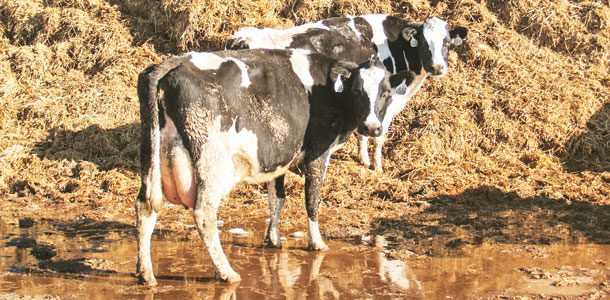As a professional hoof trimmer, primarily dealing with dairy cows, the last two decades have afforded me the opportunity to see and work with an extremely wide range of problems relating to mobility and lame conditions in those cattle under a variety of management situations.
Digital dermatitis, often referred to as “heel warts” or “hairy heel warts,” is one of the major challenges dairy farmers have to deal with relating to lameness in their herds. Heel warts can be very painful for the affected cows, frequently impacting mobility.
This constitutes a very real financial burden for the dairy farmer, not to mention a significant animal welfare issue as well. There is some good news. Much can be done now to successfully treat digital dermatitis. Even better, there is much that can be done to successfully reduce, or prevent, digital dermatitis in a well-managed herd.
From my observations over the years, the following conditions seem to foster higher rates of digital dermatitis: overcrowding, a continually wet and dirty environment, uncomfortable and dirty bedding, flies (which tend to irritate the animals) and poor body condition.
It appears that cows in high-stress situations have a higher rate of digital dermatitis. Successful prevention and treatment of digital dermatitis will involve several different management practices, many of which will benefit your herd in other ways as well. The list could be exhaustive, and every dairyman knows a perfect condition is not a practical solution.
Nevertheless, a few general suggestions relating to general cleanliness of the herd are as follows:
- Reduce crowding where possible. Do your cows have adequate bunk space and sufficient and comfortable lounging space?
- Look at what can be done to reduce the cow’s time walking through or standing in mud, water or waste.
- If there is a fly problem (there is a fly problem if your cows are being bothered by flies), it would be well worth the effort to maintain a cleaner environment, which serves to reduce the fly population afflicting the herd.
While there is no authoritative scientific support for this conclusion, there is definitely plenty of experience among dairymen, as well as the extensive observations of this hoof trimmer, which would indicate that flies facilitate the spread of digital dermatitis.
The overall suggestion with respect to irritants is that a reduction in stress situations for your cows will reduce the occurrence of the disease in your herd.
Well-maintained and managed footbaths are very effective at reducing and preventing digital dermatitis. There are several different chemicals proven effective at digital dermatitis control when used in footbaths at proper concentrations.
Stick with a product with a proven track record; let someone else be the experimental guinea pig on a new, unproven product. It’s better to know first how well something new works before using it yourself, and the experience of others is almost always the best way to learn in these situations.
Footbaths
Some important considerations regarding footbaths include the following:
- The cleaner your cows’ hooves and legs, the more effective the footbath will be. The chemical in the footbath will only work if it comes in contact with the hoof and lower leg; it won’t be effective if it only comes in contact with manure or mud.
- Use a footbath of sufficient length so that the cow must put all four hooves in it for at least a couple of steps, which is around 10 to 12 feet long.
- Change the chemical mixture, flush and clean the footbath as recommended by the manufacturer. If the footbath becomes contaminated, the chemical concentration will degrade to the extent that it will not be effective and may actually increase problems.
It isn’t possible to give universal advice on how many animals should use the footbath before the water and chemical mixture is changed. Each herd situation is unique. Of course, one of the most significant variables to begin with is the cleanliness of the cattle going through the footbath.
Additionally, it matters greatly whether the footbath is set up in such a manner that the cows can stop long enough within the bath to produce waste, or if they are encouraged to calmly walk through.
Obviously, under the former scenario, the water-chemical mixture will be fouled much sooner than under the latter condition. One of the more effective footbath systems I have observed is one in which the cows walk through a footbath with clean water (no chemicals in water) that is changed very regularly followed by another footbath, about 12 feet farther, which contains the chemical mix.
The first footbath is very helpful at keeping the second footbath clean for a much longer time and helps clean the hooves so the product in the second footbath has more opportunity to do its job of effective digital dermatitis control.
While well-managed footbaths are very effective at reducing and preventing digital dermatitis, it is this hoof trimmer’s experience that footbaths are not highly effective at treating existing digital dermatitis outbreaks.
From my 20 years in the business of hoof trimming, the most effective system I have observed for dealing with digital dermatitis outbreaks is treatment of the individual animal’s affected hoof.
Using systemic antibiotics to treat digital dermatitis does frequently have favorable results, but this method can come with some unnecessary risks, including antibiotic residue.
Also, use of systemic antibiotics, in my experience, is simply not as effective as topically treating the affected hoof. Treating the affected hoof is most easily done in a hoof trimming chute where the cow can be effectively and safely restrained.
A treatment protocol from which I have observed very favorable results is the process of first cleaning all manure, mud and debris from the affected area followed by application of a generous amount of tetracycline to the treatment site using a cohesive wrap to retain medication in the affected area.
Topical treatment of digital dermatitis
Some things to keep in mind when topically treating digital dermatitis:
- The sooner you treat a digital dermatitis occurrence, the more favorable the treatment outcome.
- Treat as soon as an occurrence is noticed; it won’t get better on its own with time.
- When cleaning an affected area, it is counterproductive to cause the site to bleed, as it dilutes the treatment and causes unnecessary pain to the cow.
- If you wouldn’t use the treatment product on yourself to clean a wound, maybe you shouldn’t use it on the cow.
- The sole purpose of the wrap is to hold the treatment product in place; the wrap is ineffective at keeping the affected area clean. It is very important to remove the wrap if it is still on three days after placement. Do not leave a wrap on the hoof for more than three days, as it can be very counterproductive.
In summary, stress and filth increase digital dermatitis occurrence. Digital dermatitis appears to be quite contagious. Footbaths, managed properly, are very effective at reducing and preventing digital dermatitis occurrences.
Topically treating digital dermatitis outbreaks has very favorable results. Use footbaths to reduce and prevent digital dermatitis and individually treat digital dermatitis occurrences.
Controlling and treating digital dermatitis is not inexpensive. It takes time, resources and work. Nevertheless, it is considerably more cost-effective to prevent digital dermatitis and very quickly treat it when an occurrence does happen than it is to let the problem linger. This is not a problem that will go away if ignored. PD
All of the information contained in this article is based on my personal experience and observations over the years I have been hoof trimming. (The information contained in this article is not intended nor should it be taken as veterinary advice.)
PHOTO
Look at what can be done to reduce the cow’s time walking through or standing in mud, water or waste. Photo by PD staff.

John Esplin
Esplin Dairy Hooftrimming










